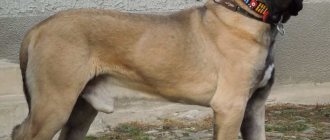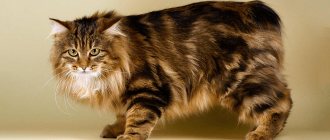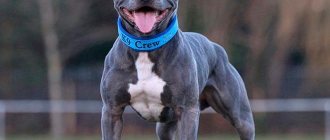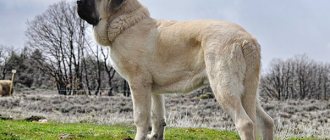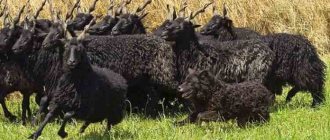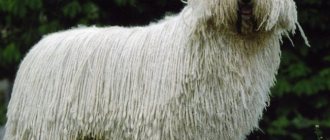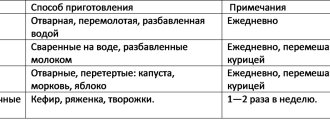History of the origin of the breed
The Puggle breed is young, its history goes back less than thirty years. The first dogs from the mating of a pug and a beagle were obtained in the USA in the late 1980s by accident. Over the next ten years, the breeds were crossed on purpose, and as a result they got a third one, which quickly became popular. The first breeder was Vols Havens from Wisconsin. He gave the breed the name “puggle” and tried to register it with the American Kennel Club of Hybrids.
He failed; his work was recognized as “not meeting the criteria for genetic experiments.” In the 2000s, his breeding work was suspended and banned in 2008. Now this is a breed unrecognized by cynological associations; it does not have its own club. Existing puggles are descendants of the first generation beagle and pug. Alternative names: mogl, puggle.
Photo: flickr.com
Selection and price of a puggle puppy
Puggles are not registered in any canine community. On the Internet, on various websites and message boards, offers for the sale of puppies periodically appear; they are often given away relatively inexpensively or even for free. Less often, puggles come to Russia from abroad, puppies are brought.
You should only buy a puppy from breeders who use valuable breeding dogs (pug and beagle) to produce mixed breeds. Parents must be tested for known hereditary diseases, have a balanced psyche and good conformation. Random matings increase the risk of producing puppies with various anatomical, physiological and behavioral problems. It is important to pay attention to the conditions in which the dogs are kept, and also to make sure that the puppies have had enough time with their mother. A responsible breeder begins to socialize babies from an early age, accustoms them to the toilet, walks, people, various animals, and will not give away an unvaccinated baby under 2.5 months.
When buying a dog, it is very important not to run into scammers who, under the guise of expensive puggles, sell pug mixes with other breeds, including mongrels, or actually breed pugs and beagles, but use dogs of average or low quality, often with various kinds of hereditary diseases.
Otherwise, when choosing a puppy, they are guided by the standard rules for choosing a healthy dog. Externally, babies should be active, well-fed, not aggressive or timid, with a good appetite, and without external signs of disease or illness.
Abroad, puggle puppies cost an average of $600. In Russia, as mentioned above, their prices vary over a very wide range. If the parents are dogs from kennels with a good pedigree, their puppies can cost more than 20,000 rubles. Mestizos obtained from amateurs are often given into “good hands” for a purely symbolic fee.
Description of the breed
As a result of crossing known breeds, the puggle is considered a decorative dog. The Puggle's appearance shows signs of both "parent" breeds. The “folded” face was “given” to him by a pug, the tail, ears and height were given to him by a beagle. Due to variations in the combination of genes in each case, the conformation of the dogs varies, but breeders strive to incorporate the best of both parent breeds into the Puggle.
Puggle is a medium-sized dog: at the withers they reach 30-35 cm and weigh 10-12 kg. There is a toy variety of the breed, its weight is 4-8 kg. They live 12-15 years.
The breed standard is not documented, so the appearance of puggles varies depending on the appearance of the parents. The head shape of puppies can be either a pug or a beagle. Variations in the shape of the body and ears are also the norm. However, these dogs have a stocky, athletic body with a high, curled tail, and floppy ears like a beagle. The coat is short and thick, most often colored brown-yellow, brown or black. The eyes are dark, deep-set.
Similar breeds
- Size: Cavalier King Charles Spaniel, Japanese Spitz, Beagle, Small Poodle.
- By character: hounds, dachshunds, terriers, pinscher, husky, setters, border collies.
- By type of face: Pekingese, Shih Tzu, bulldog, pug, boxer, griffon.
- By hypoallergenicity: West Highland white terrier, whippet, shih tzu, giant schnauzer, mini poodle, Hungarian shepherd.
Appearance
The appearance of puggles shows the traits of both parents, but it is difficult to say in advance which ones will be inherited. In one litter, puppies can be completely different from each other.
In most cases, the face is passed on to the offspring of the pug but differs in the length of the nose. Puggles are usually quite stocky, weigh 10-15 kg, and the height at the withers varies between 30-35 cm.
As for the coat and color, the parents are similar. The coat is short, shiny, lying close to the body. During the winter, the dog becomes overgrown with undercoat of varying densities; less often, it is absent. The color of a pug or beagle can be any. Often the muzzle is decorated with a dark mask. If mixed breeds of the first generation (from a pug and a beagle) more often inherit the color of a pug, then in the second generation (puppies from two puggles) the manifestation of the tri-color color of a beagle is more likely.
A puppy named Earl (pictured below) played an important role in popularizing the breed. A few years ago, he was called a worthy rival to the famous gloomy cat Grumpy and a new Internet star. Earl's popularity came after his photos were published on Reddit. The owner of the gloomy puggle, Derek Bloomfield, says that despite his gloomy expression, the dog is very active, playful and cheerful.
Character and behavioral characteristics
The puggle is a stubborn dog, but it can be raised and trained using positive methods (rewarding with words, treats, or play). Obsequiousness may be present, but this is not a necessary character trait of the dog. Puggle loves to follow his owner with his tail. The puggle gets along well with adults, children and dogs without any aggression. Only small animals take risks: puggles love to run after them. You won't make a dog into an evil guard, but he can warn you about the arrival of a stranger.
Puggles are smart, energetic dogs with a lot of energy. If dogs are healthy, you will not see them melancholic. The beagle also gave them a characteristic howl, and this can become a problem in an apartment. Walk your puggle in the morning and evening for at least half an hour. Long, active walks will make your dog calmer and quieter at home.
Here in the video you can see how a puggle drives!
Character
Puggles are playful, balanced dogs, smart and affectionate, very active and curious. The excellent sense of smell they inherited from the Beagle forces them to constantly explore new smells. Form a close bond with the owner and thrive in the company of family. Puggles will bark loudly to notify the owner of the arrival of guests, but they are not guard dogs and will not defend themselves.
The character of puggles can bring the owner a lot of pleasant and not so pleasant surprises. It is not uncommon for them to inherit a share of stubbornness and a tendency to chase other animals, excessive intrusiveness and excessively noisy behavior. By nature, they are very social, people-oriented, and need constant attention and care.
Well suited for people who are getting a dog for the first time, for families with small children and the elderly. Puglis are easy to learn and consider it their duty to please and entertain the family. A little noisy and active at a young age, after a year they become calmer and more reasonable. Puggles get along well with other pets if raised together. They can play with children for a long time. However, the appearance of another animal or baby with an adult dog can cause jealousy on the part of the four-legged friend.
Puggles easily adapt to the family lifestyle, easily endure moving if their beloved owner is nearby, but they do not cope well with loneliness. Bored dogs often develop bad habits that include howling, excessive barking, and damaging things. If you give the dog enough attention in the morning and evening, provide good physical and mental exercise, and also leave a certain amount of toys, it will calmly wait for the person from work.
Education and training
Do not keep your dog alone, for example, in the yard of a private house. Puggle is very sad without people, he may develop bad habits (barking, howling, digging holes). To get a pleasant, friendly dog, introduce it to other animals, people, places, smells, sounds from childhood. The more complete the socialization and training during puppyhood, the fewer behavior problems the dog will have as an adult.
Teaching a puggle commands is only possible with encouragement; Punishments will only increase the dog’s stubbornness and damage its psyche. But even a trained puggle will run away if it smells an unusual odor. Therefore, walk and play with your pet in a fenced area or on a long leash. An unvaccinated puppy cannot be walked, so he needs to be accustomed to a diaper or tray, and later to being walked.
Photo: wikimedia.org
Pros and cons of a hybrid breed
To decide which camp (supporters or opponents of the breed) is closer to you, consider the positive and negative features of this breed “mix”.
Advantages of mestizos:
- Sociability and friendliness towards people.
- Cheerful character and playful disposition.
- General health.
- High level of intellectual abilities.
- Attachment to people.
- Loyalty to the owners.
- Lack of aggression.
- Ability to get along with other pets.
- Hypoallergenic.
- Activity and endurance.
- Unpretentiousness.
Cons of mestizos:
- Stubborn character.
- Hyperactivity.
- Excessive gaming.
- Tendency to destructive behavior when alone (they can howl, constantly bark, chew things).
- The presence of genetic diseases of both breeds (problems with vision and breathing, joint dysplasia).
- They require constant attention from the human owner.
- They can be touchy.
- They can be lazy.
Diseases
The Puggle is a hybrid and therefore generally healthy breed of dog, but some of the common sores found in Pugs and Beagles may appear.
Brachycephaly
This is an artificially created, genetically fixed defect of the puggle. Reason: congenital deformation of the skull bones, reduced volume of the nasal cavity with a normal mucous membrane. Air passes through the narrowed nostrils with difficulty, the dog breathes with a whistle or wheezing, quickly gets tired, coughs, loses consciousness and suffocates.
Noisy breathing is not normal for a puggle. If you notice this in your pet, contact your veterinarian. In most cases, treatment is surgical widening of the nasal passages.
Hip dysplasia
A malformation of the skeleton of the limbs, in which abnormal friction in the joint destroys the cartilaginous lining, causing pain to the animal. Symptoms: lameness, unsteadiness, x-shaped rear legs, fatigue, painful rise from the litter.
Puggles have a hereditary predisposition to underdevelopment of the acetabulum, but this defect does not necessarily appear in all representatives. Good nutrition and adequate exercise during puppyhood reduce the risk of dysplasia. A severe type of defect requires surgical intervention.
Epilepsy
Periodic seizures in a dog. Puggles can inherit it (~ up to 3 years), or they can get it as a result of injuries, infections, poisoning, diseases of internal organs (kidneys, liver), malnutrition, parasitosis or prolonged stress (from 4 years and older). If your dog experiences his first seizure, consult your veterinarian. This disease is incurable, but can be corrected with medications. Write down the dates and duration of attacks: your doctor may need this information.
Hypothyroidism
Lack of thyroid hormones can be congenital or acquired. Due to congenital conditions, the Puggle may develop dwarfism and cretinism. If a pregnant bitch had an imbalance, then her puppies will also show endocrine diseases. Acquired hypothyroidism develops due to autoimmune diseases, tumors or dystrophy of the thyroid gland, diseases of internal organs, infections, and lack of iodine in the diet.
It manifests itself as weakness, a tendency to obesity for no apparent reason, high fatigue, disruption of the sensory organs, inflammation of the eye tissue, paralysis of the muscles of the muzzle, larynx, regurgitation, swelling of all layers of the skin, poor regeneration and blood clotting, infertility.
Patella luxation
This is a hereditary or acquired disease. It is caused by pathologies of the development of the musculoskeletal system or injuries of the hind limbs. Symptoms of a luxated patella: lameness, abnormal shape of the joint, the dog leans little or not at all on the affected paw. The veterinarian will diagnose the dislocation, determine its severity and prescribe medication (for the first and second) or surgical (for the third and fourth degrees) therapy.
Photo: flickr.com
Possible health problems
Unfortunately, in addition to barking and howling, the puggle inherited a number of diseases from its parents. They may often encounter problems such as:
- hip dysplasia, a sign of which may be lameness on one or two legs;
- narrowed or stenotic nostrils that make it difficult to breathe (this applies to short-faced pigles);
- epilepsy, that is, convulsive seizures, which cannot be treated, and the dog must take special medications all the time;
- household or food allergies;
- hypothyroidism or deficiency of thyroid hormones, which weakens the general condition of the pet;
- “cherry eye” or third eyelid adenoma;
- cataract and glaucoma;
- chronic luxation of the kneecap, which often affects small breed dogs;
- various cardiac pathologies;
- tendency to obesity.
In addition, like any dog, puggles can “catch” various dangerous viral infections, which vaccination can help protect against.
Care
The puggle's short coat requires minimal grooming: 5-10 minutes of brushing every day with a stiff brush and bathing once a month. Keep the skin folds on your dog's face, eyes and ears clean. Untidy, these places become an excellent breeding ground for infections.
Regular removal of fleas and worms is a must. The Russian climate is a little cold for the puggle: buy or sew clothes for him for the winter. The dog won’t like the cold at home either: place his bed in a warm, dry place, closer to you.
Photo: flickr.com
Care and conditions of detention
Caring for a pugglem is not difficult. For normal development and the absence of health problems, it must be fed in a balanced manner, provided with a sufficient number of walks and physical activity.
How to train to use a litter box and to walk outside
Due to their natural stubbornness, puggles are very difficult to potty train. But he needs walks. Until the puppy is vaccinated, it is not taken outside. In puppies, the bladder cannot tolerate the urge. He will do his business wherever he has to. But gradually he still needs to be accustomed to using the toilet in one place. First, lay disposable diapers where he is most often found. It is better to lock him in a limited space so that he remembers that he needs to go to the toilet in a certain place.
After a few weeks you can purchase a tray. As soon as the dog gives “signals” that it wants to relieve itself (sniffing the floor, sitting down, freezing in place), put it on the tray. Determine a permanent location for the tray. It is better to place it closer to the front door. Subsequently, this will help to quickly accustom the puppy to walking outside.
Feeding puppies and adult dogs
Puggles have a good appetite, but if they don’t move much, they begin to gain excess weight and develop obesity. Puppies should first be fed the food they are accustomed to from the breeder. Introduce new foods gradually, in small portions, and observe the body’s reaction. The number of feedings per day for puppies is 4-5; for adult dogs they should be reduced to 2-3. If you choose ready-made food, it should be of the holistic or super premium category.
Brands of ready-made high-quality dog food:
- Go;
- Monge;
- Royal Canin;
- Bosch;
- Akana;
- Orijen;
- Barking Heads;
- Brit;
- Eukanuba;
- Arden Grange.
When feeding natural foods, to obtain sufficient energy and develop muscle mass, 50% of the food should be protein. The diet should include:
- lean meat;
- offal;
- boneless fish;
- dairy products.
A dog can get carbohydrates from cereals (buckwheat, rice) and vegetables. Food should be at room temperature, and portions should be commensurate with the age of the pet.
Place to sleep
Puggles cannot live on the streets. Therefore, they need to arrange a place in the house in advance, closer to the owner. These dogs are afraid of the cold. The place for sleeping and rest should be in a warm, dry place, without drafts. From there, the horizon should open to everything that happens in the house, so that the animal does not feel lonely.
Hygiene
The Puggle has short hair, which is why it is considered a hypoallergenic dog. But from time to time she sheds, periodically the fur has to be combed with a furminator or a special brush with stiff bristles. You can use a special glove. You can bathe your dog no more than once a month. After a walk, wipe your paws with a damp towel, or use a special paw washing device.
Ears and eyes are cleaned once a week. For this purpose, use a sponge moistened with boiled water. If there are ear mites, treatment can be carried out with an antiseptic to remove wax. Once every 3-4 weeks, trim the nails with special clippers; if the dog runs around outside enough, they will grind down on their own. It is also necessary to brush your dog’s teeth several times a week to remove hard plaque and prevent tartar deposits.
Walks
Once vaccinations have been completed, the puppy can be gradually taken out for walks. At first they should last 10-15 minutes. They are gradually increased to 1 hour. Walks should be active so that the puggle spends the maximum amount of energy on them. Then at home he will behave more calmly.
You need to walk your dog on a leash or a special harness. You can only release it if there are no roads or construction sites nearby, and you are sure that the pet will not run away somewhere and start digging the ground or chasing small animals.
Toys
Their choice should be based on the dog's temperament. Puggles are very active and inquisitive. Balls, Frisbees, and tug-of-war ropes are suitable for them to play outside. At home they can be occupied with various toys: rubber bones, imitation birds, baits. The more toys there are, the more interesting it will be for the dog. You can hide toys in several places so that your dog can “hunt” for them.
Vaccinations and treatment against worms
Puggles are vaccinated according to the same schedule as other dogs. Deviations are possible if the dog is not completely healthy or has parasites. 10-12 days before each vaccination, it is necessary to remove worms from the dog using special deworming drugs. Eliminate lice, lice-eaters, fleas and ticks, if any, in advance.
Vaccination schedule:
- at 1.5-2 months;
- after 3 weeks – revaccination;
- at 6-8 months – comprehensive vaccination with the addition of an anti-rabies injection;
- at 12 months, followed by annual revaccination.
Cloth
Puggle is very afraid of cold weather. In severe frost it is better not to let him go outside. For walks in damp and cool weather, purchase overalls that will protect you from colds.
Feeding
An active puggle needs a lot of energy to play continuously. If the dog is inactive, then with a good appetite, he quickly gains excess weight. Choose high-class industrial dry food (super premium, holistic).
In your dog's natural diet, include 50% protein (lean meat, fish, dairy products, eggs), the rest - cereals and vegetables with fruits. Don’t forget about multivitamin complexes, since dogs most often lack vitamins and microelements in natural food.
Puggle puppies need feeding 4-5 times a day, adults - 2-3 times a day (relatively calm dogs need to be fed less often). Make the serving size appropriate for the age and weight of your pet. Make sure he eats it quickly and without leaving a trace. If you left it, be sure to remove it before the next feeding.
They are very energetic! Look at Mafi Daria Dontsova!
How to choose a puppy
Before getting a puggle, assess your preparedness for possible problems associated with the character, behavior and hereditary diseases of the puggle. If possible, choose a puppy personally, but with puggles this is difficult, since most of these animals are brought from abroad “to order”.
The dog must be active, clean, healthy, with shiny fur and clean eyes and ears. Ask the breeder about the health of the puppy’s parents and any hereditary diseases they have. As part of the documents, the puggle must have a veterinary passport with notes on vaccinations and treatments performed.
There cannot be an official pedigree or metric issued by any canine organization, since the breed is not recognized by any of them.
Price and where to buy a puppy
A puggle puppy costs $500 and up. In Russia this breed is not practiced professionally, but abroad, for example, in America, there are enthusiasts of this business. American dog breeding regulations prohibit crossbreeding between puggles and puggles, and if you're looking to buy a puppy in the US, you'll likely have to agree to that rule, too.
Choosing a puppy
The cost of puppies in this breed can vary greatly. If in the USA puggles are considered prestigious dogs for elite owners and are offered on average for two thousand dollars, then in our area breeders are ready to sell a baby, naturally, without documents, for much more modest money - a small puggle in Russia can be found for about a hundred dollars or even cheaper.
But here are two questions that should concern you if you are interested in purchasing an inexpensive, fashionable elite breed:
- Is it really a puggle?
- puppy health.
The same type of puppies in a puggle litter is rare and indicates a good selection of the parent pair
Often the desire to place puppies from random matings and even get money for it pushes breeders to deceive. But recognizing such a trick is usually not difficult at all - it is most often resorted to by the owners of a pug bitch who failed to look after her during her “critical days.” Yes, mother’s traits will certainly be recognizable in the heirs, no matter who the “scoundrel father” is. But we remember that a real puggle must have a beagle mother, and nothing else. And in this case, the puppy will look like a pug only if a male of the corresponding breed participated in the mating.
There is nothing prohibited in the desire of a breeder to experiment by mating purebred dogs, a pug with a beagle - this is his right, no matter how controversial the feasibility of such mating may be. But not everyone adheres to the first rule of any breeding - to use only valuable breeding material. You risk getting a puppy from parents who are only vaguely similar to the declared breed. And the worst thing will be that the questionable health of such a “breeding couple” will be inherited by their descendants.
Puggle puppy is adorable
Do not buy a puppy from those you cannot trust and be sure to come in person to the viewing, ask for documents confirming the breed and health of the parents. If you are asked to trust only the seller’s word of honor, be prepared for various problems to arise, perhaps even very serious ones.
Owner reviews
Sergey: “Funny dogs have fallen, it’s true. Very active, to the point of outrageousness, so much so that it seems they won’t be able to live in an apartment. And a loud howl... The neighbors can no longer stand it.”
Rada: “I received a puggle as a birthday present from my husband. It was such a surprise. I have been “enjoying” him for three years now, and for all three years Zhorik has been howling, ruining his favorite flower beds, running almost without breaks and snoring. But he’s loyal, and he has a funny face.”
Photo
Photo: wikimedia.org
Photo: wikimedia.org
Photo: wikimedia.org
Briefly about the main thing
- The Puggle is a little-known, unrecognized breed of dog, a cross between a Pug and a Beagle.
- These dogs are friendly, very active, loyal but stubborn, and love to bark and howl.
- This breed is predisposed to brachycephaly, dysplasia, patellar luxation, hypothyroidism, and epilepsy.
- It is difficult to choose a puggle puppy, since they are bred mainly abroad.
Did you like the article? Share it with your friends on social media. networks. This will help them get useful information and support our project.
Health and life expectancy
First generation puggles, that is, puppies born from a pair of pugs and beagles, as a rule, have better health than their parents and future children. However, this does not exclude the possibility of inheritance of various diseases:
- Eye diseases (dry cornea, inflammation of the third eyelid);
- Allergies;
- Hip dysplasia;
- Brachycephalic syndrome in dogs with a short muzzle;
- Dislocation of the kneecap;
- Arthritis often develops in old age, making puggles more susceptible to cold and infections.
Breeders are trying to reduce the number of inherited diseases to a minimum, allowing only healthy producers into breeding, but not all of them. Life expectancy is usually 10-15 years, provided good care and nutrition. Puggles are required to be vaccinated according to the generally accepted schedule, starting from puppyhood and then annually throughout their lives. Regularly treated against external and internal parasites.
How puggles are bred
In a pair of parents, the dad is usually a pug and the mom is a beagle. This is explained by the fact that the birth of small puppies in beagles occurs without complications, while pugs often cannot give birth to large puppies normally, do not carry them to term and even die.

